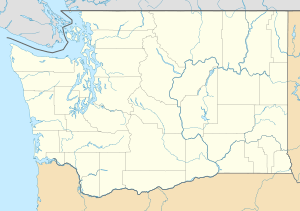McNary National Wildlife Refuge facts for kids
Quick facts for kids McNary National Wildlife Refuge |
|
|---|---|
|
IUCN Category IV (Habitat/Species Management Area)
|
|
| Location | Walla Walla County, Washington, United States |
| Nearest city | Pasco, Washington |
| Area | 14,664.54 acres (5,935 ha) |
| Established | 1956 |
| Governing body | U.S. Fish and Wildlife Service |
| Website | McNary National Wildlife Refuge |
The McNary National Wildlife Refuge is a special place where wild animals and plants are protected. It is one of many national wildlife refuges in the United States. The United States Fish and Wildlife Service manages these refuges.
This refuge is located in southeastern Washington. It stretches along the east side of the Columbia River. It goes from where the Snake River joins the Columbia, down to the Walla Walla River. Part of it even goes into Oregon. Even though it's in a quiet, rural area near Burbank, it's also very close to the busy Tri-Cities area. This includes Kennewick, Pasco, and Richland. Because it's so close to a city, it's sometimes called an "urban refuge."
Contents
Amazing Birds at McNary Refuge
McNary National Wildlife Refuge is home to an incredible number of waterfowl. Waterfowl are birds like ducks, geese, and swans. You won't find this many waterfowl in many other places in North America. Visitors often see huge groups of Canada geese and mallard ducks.
Mallards and the Pacific Flyway
More than half of all the mallards in the Pacific Flyway spend time here. The Pacific Flyway is like a superhighway in the sky for birds. It's a major path that birds use to fly between their breeding grounds in the north and their warmer winter homes in the south. Many mallards stay here during the winter. This part of the Columbia River Basin is very important for them.
Other Waterfowl and Birds
Besides mallards, many other waterfowl species use the refuge. These include green-winged teal, shoveler, canvasback, ring-necked ducks, and lesser scaups.
The refuge is also a safe place for other types of birds. You can find shorebirds and wading birds here. Even large birds of prey like bald eagles and peregrine falcons live here. Thousands of water birds build their nests together on the river islands. These islands are safe places for them to raise their young.
Habitats and Fish
The McNary National Wildlife Refuge has many different types of natural areas. These different areas are called habitats. They provide homes for many different animals.
Diverse Habitats
The refuge includes:
- Backwater sloughs: These are calm, slow-moving channels of water.
- Shrub-steppe uplands: These are dry, open areas with shrubs and grasses.
- Irrigated farmlands: These are fields where water is added to help crops grow.
- River islands: These are pieces of land surrounded by river water.
- Delta mudflats: These are flat, muddy areas where a river meets a larger body of water.
- Riparian areas: These are areas along the banks of rivers and streams.
Important for Salmon
The wetlands and shoreline bays in the refuge are very important for fish. They act as a nursery for young fall chinook salmon. A nursery is a place where young animals can grow safely. These young salmon need these areas to develop before they swim out into the wider river.


